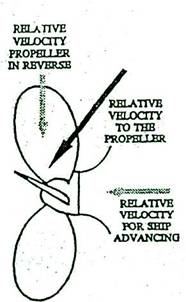Question
With reference to arresting the headway of
vessels of considerable mass, give reasoned opinions on EACH of the following
statements:
(a) Full
power availability for astern running of the propeller is inconsequential;
Results have been disappointing in those instances where rudders have been
adapted to act as retarders; Discreet use of transverse thrust units may reduce
stopping distance.
Answer.
(a) The propeller blade section is of
aerofoil shape designed to give optimum efficiency when traveling ahead, with
an angle of attack (incidence) dependent upon service speed and propeller
speed.
This results in a propeller efficiency of around 60%
to 70%, with most of the thrust (about 80%) arising from the suction pressure
on the back (forward side) of the blade.
The combination of travelling ahead and reversing the
propeller revolutions will give a high angle of attack on the back of the
blade.
The propeller will absorb very little of the available
power, severe eddying will occur on the face and efficiency is very low. Thrust
mainly comes from the high pressure on the back of the blade.
If, say, 80% of the full power were available astern,
then boosting this to 100% would have a minimal return in thrust since the
propeller is operating so inefficiently.
Therefore the availability of full power astern when
arresting a large vessel under headway can be said to be inconsequential.
(In tests on a 165000 tonne
tanker, a 50% increase in power only resulted in a 16% reduction in stopping
distance.)

(b) In tests using rudders as retarders, it was found
that the rudder area was too small to have any great effect on increasing the
stopping distance. The rudder area would have to be increased about 5times to
half the stopping distance. Furthermore, large slow speed ships have lower
rudder force generated, since the force, produced is proportional to the square
of the ships speed.
Alternate thrust to port and starboard by transverse
thrust units (particularly in the bow) will cause the ship to 'yaw'. The yawing
movement of the ships will absorb the forward momentum more than the normal
ahead travel and thus retard the ship.